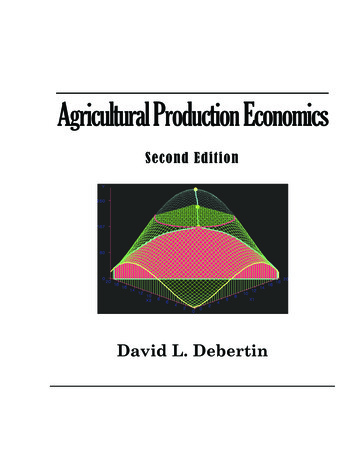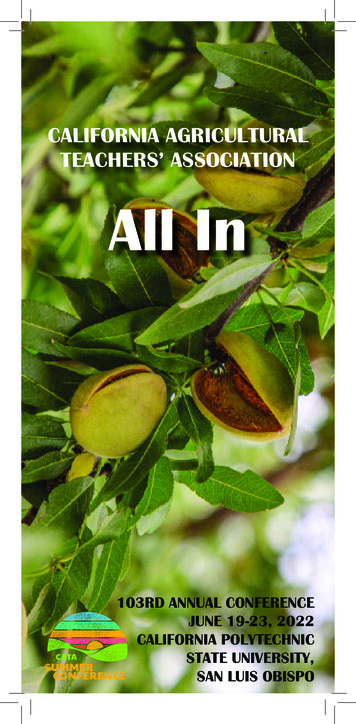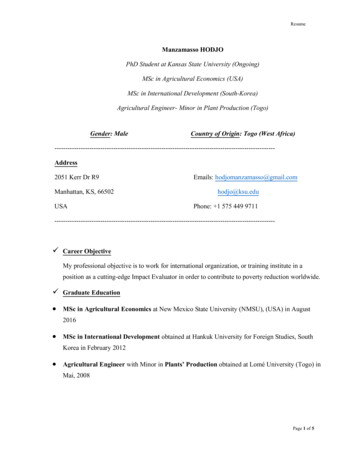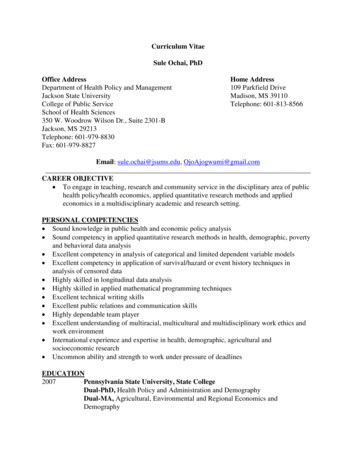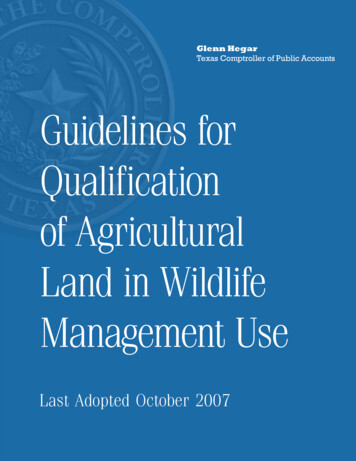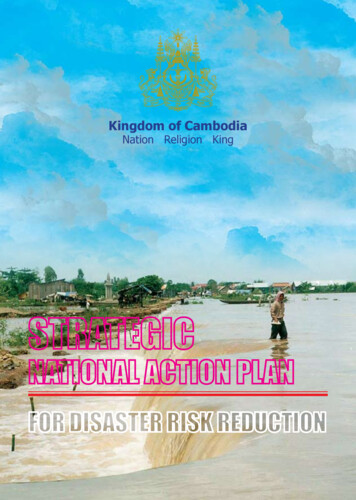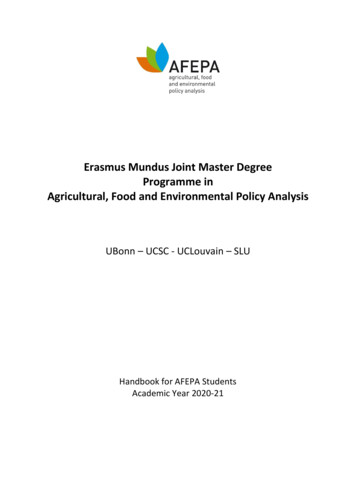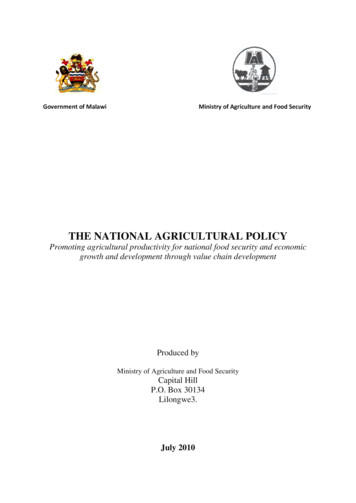
Transcription
Government of MalawiMinistry of Agriculture and Food SecurityTHE NATIONAL AGRICULTURAL POLICYPromoting agricultural productivity for national food security and economicgrowth and development through value chain developmentProduced byMinistry of Agriculture and Food SecurityCapital HillP.O. Box 30134Lilongwe3.July 2010
TABLE OF CONTENTSACRONYMS AND ABBREVIATIONS . iiiFOREWORD . iv1.0 INTRODUCTION . 11.1Importance of agriculture in Malawi . 11.2Evolution of agricultural policy in Malawi . 11.3Rationale for the policy development . 21.4Guiding Principles . 22.0 THE NATIONAL AGRICULTURAL POLICY . 32.1Vision. 32.2Policy Goal . 32.3Mission . 32.5Specific Policy Objectives . 43.0THEMATIC AREAS OF THE POLICY. 43.1INPUTS USE AND MARKETS . 43.1.1Fertilizer . 43.1.2The seed sector . 53.1.3Herbicides and fungicides . 63.1.4Livestock feeds . 83.2AGRICUTURAL PRODUCTION . 93.2.1Food and Nutrition Security . 93.2.2 Agricultural Extension . 113.2.4Land Resources Management . 123.2.5Crop Production . 133.2.5.1 CURRENTSITUATION . 133.2.6Fisheries and Aquaculture Development . 143.2.7Livestock . 153.3AGRICULTURAL MARKETS DEVELOPMENT . 163.4GENDER, HIV AND AIDS AND AGRICULTURAL DEVELOPMENT . 173.5CLIMATE CHANGE AND ENVIRONMENTAL ISSUES . 183.6BIOFUELS AND AGRICULTURAL DEVELOPMENT . 194.3Policy Coordination . 204.2Institutional Coordination . 21ii
ACRONYMS AND PGDPGMOIDEAUS re Development DivisionAgriculture Development ProgrammeAgriculture Development and Marketing CooperationAgricultural Market Information SystemsAfrican UnionAgriculture Sector Wide ApproachAgricultural and Livestock Development Strategy and Action PlanAgriculture Technology Clearing CommitteeComprehensive African Agriculture Development ProgrammeGross Domestic ProduceGenetically Modified OrganismsInitiative for Development and Equity in African AgricultureUnited States DollarStructural Adjustments ProgrammeMalawi Agriculture Commodity ExchangeMalawi Agricultural Sector Investment ProgrammeMalawi Growth and Development StrategyNational Agriculture PolicyNew Partnership for Africa’s DevelopmentNon Governmental OrganizationPlant Variety ProtectionInternational Union for the Protection of New Varieties of PlantsConsultative Group on International Agriculture Research Centersiii
FOREWORDThe National Agricultural Policy seeks to raise the profile of the agricultural sector so that iteffectively contributes to the national development aspirations of turning the country from apredominantly consuming to a producing and exporting nation targeting all value chain stages.The National Agriculture Policy builds on the various policy statements in the sector to giveguiding principles to improve agriculture productivity in the wake of various national, regionaland global opportunities and challenges. The vision of the National Agriculture Policy is to havea nation that enjoys food security and sustainable growth and development. The policy goal is tocontribute to the attainment of national food security, poverty reduction and national economicdevelopment as outlined in the Malawi Growth and Development Strategy (MGDS).The Ministry of Agriculture and Food Security realizes that to attain this goal in the countryrequires concerted effort by all players in the sector with a common vision. The NationalAgriculture Policy will act as a guiding principle to all players as we move together in achievingthe MGDS and Millennium Development Goals (MDGs) in the short, medium and long term.The Ministry appeals to all stakeholders to work together in Agriculture sector as it is thebackbone of Malawi’s economy. The Government endeavors to use resources in the budget in theimplementation of this policy within the Agriculture Sector Wide Approach (ASWAP)framework which is now taking the programme approach to implement all its activities andpulling resources together.Andrew T. Daudi, PhDSecretary for Agriculture and Food SecurityJuly 2010iv
1.0INTRODUCTION1.1Importance of agriculture in Malawi1.1.1. Since independence in 1964, the agricultural sector has remained the mainstay ofMalawi’s economy as it accounts between 36 and 39 percent of the GDP, employs about80 percent of the workforce, accounts for over 80 percent of foreign exchange earnings,and contributes significantly to national and household food security.1.1.2. The agricultural sector has two main sub-sectors - the smallholder sub-sector contributingmore than 70 percent and the estate sub-sector that contributes less than 30 percent toagricultural GDP. Smallholders cultivate mainly food crops such as maize, the mainstaple grain, cassava and sweet potatoes to meet subsistence requirements, while theestate sector focuses on high value cash crops for export such as tobacco, tea, sugar,coffee and macadamia. Smallholder farmers cultivate small and fragmented land holdingsunder customary land tenure with yields lower than in the estate sector.1.1.3. In Malawi, the total area under cultivation is estimated at 2.2-2.5 million hectares, ofwhich more than 90 percent is in small farms. It is estimated that the potential agriculturalland is about 4.7 million hectares suitable for rainfed, dimba, or wetland cultivation,irrigated land, and plantations plus 0.9 million hectares of grassland. This means thatabout half of Malawi’s land area can be cropped, of which only about half is currentlyunder crops.1.1.4. Development resources, strategies and policies in Malawi since independence have beenheavily biased towards agricultural development. While the country has gone throughdifferent periods of viable agricultural sector accompanied by food insecurity, recentlythe sector has had impressive growth trends which need to be supported with right policyand institutional environment.1.1.5. Agricultural exports have remained undiversified, with little value addition. About 40percent of the population live below the national poverty line (MK44 or UD 0.3 perperson per day) with 22.4 percent barely surviving. Socio-economic indicators illustratethe depth and intractability of poverty. For example, the levels of malnutrition remainhigh with 43.2 per cent of under-five children stunted and 22 per cent underweight.1.1.6. The country’s macroeconomic performance has been strong for the past three years due tosound economic policies pursued by the government and good performance in theagricultural sector. Malawi has registered a real GDP average growth of 7.5 percent andaverage inflation rate of below 10.9 percent for the past five years.1.2Evolution of agricultural policy in Malawi1.2.1Malawi’s post independence agricultural strategy has been characterized by a dual policyof attainment of national food self sufficiency through enhancement of the smallholderagriculture and rapid economic growth through estate production with almost all majoragricultural programmes, strategies and action plans being guided by the food securitypolicy.From the mid 1980s, the Malawi Government reviewed its role from that of being both apolicy formulator and implementer to that of policy regulator under the StructuralAdjustment Programmes (SAPs). Through this, all restrictions on production of somecommodities like burley tobacco by smallholder farmers were removed to accord themwith opportunities to enhance their incomes. The other important policy reforms are theremoval of agricultural input and output marketing controls, price decontrols, and thecommercialization of parastatals, amongst others.In 1995, the government developed the Agriculture and Livestock Development Strategyand Action Plan (ALDSAP) to provide a framework for coordinating the implementation1.2.21.2.31
1.2.41.2.51.2.6of various policy initiatives. Much as the ALDSAP sought to outline the aspirations forthe attainment of the sector’s objectives, its implementation registered little successbecause, amongst other reasons, the sector’s policies and strategies were numerous andoften overlapping.In 1999, the government undertook a comprehensive review of all agricultural sectorpolicies under the Malawi Agricultural Sector Investment Programme (MASIP).Unfortunately, the review never translated into a coherent policy. Meanwhile, the sectorhas several sub-sector policy documents. These policies include the Land ResourceConservation Policy, the New Agriculture Extension Policy, the Research Master Plan,the HIV and AIDS Policy for the Agricultural sector, the Livestock Development Policyand the Irrigation Policy, amongst others.In addition, the prevailing socioeconomic environment poses several challenges that needthorough considerations to achieve sustainable growth and development of theagricultural sector. In the face of these challenges, the Ministry, through the facilitation ofMASIP developed the Agricultural Development Program (ADP) in 2006. The ADPsought to enhance the coordination in implementation of sector priority programmes byall stakeholders.However, in 2007-2009, the Malawi Government formulated a sector-wide program, theAgricultural Sector Wide Approach (ASWAp) to harmonise investment and supportprograms in agriculture based on their highest potential for contributing to food securityand agricultural growth in the next five years. The ASWAp is a prioritised resultsoriented framework for implementing the agricultural components of the Malawi Growthand Development Strategy (MGDS).1.3Rationale for the policy developmentThe development of the National Agricultural Policy comes against the background of thefact that the sector has been operating without a coherent national agricultural policy. Inthis respect, the critical factors necessitating the development of the policy are as follows: Dynamics in the policy environment at the national and international levels havesignificant bearing on the agricultural sector. There is need for a policy framework toguide the sector’s operations in the face of the different policy developments that affectproductivity of agriculture technologies which, amongst others, include climate change,biofuels, gender, HIV and AIDS. The strong linkages between the agricultural sector and other sectors and theimplications for national economic growth and development. Based on the realization ofsuch critical linkages, there have been calls for clear and comprehensive policy guidancefor the sector so that it ensures continued positive contribution of the sector while othersectors continue to grow; To provide a premise for the development of sub-sectoral or industry specific policiesand legal frameworks. In the process, the policy aims at promoting sub-sectoral linkageswhich have failed to take place in the absence of an overarching sectoral policy; To provide an outline of institutional linkages amongst various stakeholders (public orprivate) which have a significant bearing on the agricultural sector. It is recognized thatinstitutional linkages are dynamic and evolve depending upon the prevailing national andinternational social, economic, political and cultural environment.1.4Guiding PrinciplesThe Policy builds on the various policy statements that already exist in the sector andoffers actions that need to be taken to improve agriculture productivity in the wake ofvarious national, regional and global opportunities and challenges.2
Realignment to regional and international policies. The Policy realigns itself to theregional and international policies on agriculture, climate change and environmentalmanagement issues notably the Comprehensive African Agriculture DevelopmentProgramme (CAADP), an agricultural programme for the New Partnership for Africa’sDevelopment (NEPAD)/African Union (AU). CAADP was endorsed by AfricanGovernments with the aim of increasing public investment in agriculture by a minimumof 10 percent of the national budgets in order to achieve an annual growth in agriculturalproductivity by 6 percent.Responsiveness to gender in agricultural and rural development. The Policyrecognizes the need for gender equality as a fundamental value in provision of agricultureservices to ensure equal participation of all gender categories.Evidenced-based decision making. All stakeholders in agricultural sector will beencouraged to make decisions that are based on analysis of issues using internationallyacceptable analysis tools and practices.Policy and institutional harmonization. The Policy seeks to promote harmonization ofvarious sub-sectoral policies to eliminate overlaps and promote complementarities withinthe sector in line with the overarching national development aspirations. The policy ispremised on the spirit of institutional partnerships within the sector and with otherstakeholders in order to ensure efficiency in service delivery.Multi-stakeholder focus. The Malawi Government’s intention is that all the serviceproviders who play key roles in the development of the sector are fully recognizedespecially as they actively take part in the implementation of guidelines laid down in thispolicy.Demand-driven approach. In line with the democratization process and other nationalpolicies such as decentralization policy, this policy seeks to ensure that all services to thedifferent farmers are according to their needs.Building on the strength of previous policy initiatives. The Policy builds on thenational experiences in the implementation of various policy initiatives undertaken in theagricultural sector in Malawi, such as the Agriculture and Livestock DevelopmentStrategy and Action of 1994, the review of Malawi Agricultural sector InvestmentProgrammes (MASIP) in 1999 and the Agricultural sector Wide Approach (ASWAp) in2008.2.0THE NATIONAL AGRICULTURAL POLICY2.1VisionA nation that enjoys food security and sustainable agricultural growth and development.2.2Policy GoalTo contribute to the attainment of national food security, poverty reduction and nationaleconomic development objectives as outlined in the Malawi Growth and DevelopmentStrategy (MGDS).2.3MissionTo promote agricultural productivity and sustainable management of land resources toachieve national food sovereignty, increased incomes and ensure sustainable socioeconomic growth and development.3
2.5Specific Policy ObjectivesThe National Agricultural Policy seeks to raise the profile of the agricultural sector so thatthe NAP effectively contributes to the national development aspirations of turning thecountry from a predominantly consuming to a producing and exporting nation targetingall value chain stages. This would be achieved through: Facilitating the creation of a conductive and supportive policy environment foreffective development of the agricultural sector throughout all stages of the valuechain; Strengthening the capacity of the stakeholders in the sector in provision ofagricultural services; Enhancement of coordination and collaboration amongst relevant stakeholdersoperating in different sub-sectors of the sector; Provision of clear strategic policy direction to all stakeholders involved in sectorissues along the value chain stages.3.03.13.1.1THEMATIC AREAS OF THE POLICYINPUTS USE AND MARKETSFertilizer3.1.1.1 Current SituationIn Malawi, the nutrient use per hectare of inorganic fertilizer is only around 43 kg onaverage. This is much lower than the world’s average of 100 kg per ha and otherdeveloping countries. Over the years, national fertilizer sales have been around 186,000metric tons per annum, with sales reaching as far as 215,000 metric tons. Based on thearea under cultivation, if farmers apply recommended rates, potential fertilizerconsumption in Malawi could reach more than 547,000 metric tons. However, thegovernment is promoting the use of organic fertilizers and agro-forestry technologies inorder to complement imported inorganic fertilizers.Before the liberalization of inputs markets in the 1980s, procurement and distribution ofinputs to smallholder farmers was done by government-controlled companies. However,with liberalization since the mid 1990s, there has been a significant increase in privatesector participation in agro-input trading with private firms at times importing 92 percentof the fertilizers sold in Malawi.3.1.1.2 Issues from the current situationThe fertilizer industry in Malawi faces a host of demand and supply side constraintswhich include high fertilizer prices, climate change and extreme weather events (droughtand floods), inadequate farmers’ knowledge of the technical aspects of the differentfertilizers, quality of fertilizers, limited availability of credit, procurement modalities andtransportation issues, among others.4
3.1.1.3 Policy actions to improve fertilizer marketing and application Finalize and implement the National Fertilizer Policy developed in 2006.Ensure that the implementation of the public interventions in the industry such asAgriculture Inputs Subsidy Programme harness the development of the private sector,i.e., implementing market friendly public interventions.Review and reformulate the fertilizer legislation and regulations governingformulation, procurement and distribution of fertilizer.Building the capacity of the different cadres of the private sector involved in fertilizerindustry such as agro-input dealers and the middle scale private traders.Enhance skills and knowledge base of the public and private technical staff andfarmers in the use of organic and inorganic fertilizer and other inputs.Scale up public investment in road and transport infrastructure and access routes torural areas.Promotion of sustainable land and water management such as agroforestrytechnologies and organic farming among farmers in order to reduce dependency onchemical fertilizers and improve soil structure.Promote credit facilities for farmers to purchase inputs.Increase local capacity for manufacturing blending fertlisers in the country.3.1.2 The seed sector3.1.2.1 Current situationOwing to the market reforms under the SAPs implemented from the mid-1990s, therehave been huge changes in seed marketing. Prior to that, in the early 1990s, ADMARCdominated seed sales to smallholders. With reforms, farmers buy hybrid maize seeds frommore than 1000 private and public outlets throughout the country. There are three majorchannels for seed distribution from seed growers to Malawi farmers and these include: (a)informal farmer-to-farmer sale; (b) government purchase and distribution through nonmarket channels (e.g., free seed); and (c) seed company distribution through storesoutlets.With respect to market size, from a regional perspective Malawi has a medium-sizedmarket, larger than some other countries such as Mozambique, Tanzania, and Uganda butsmaller than Zimbabwe and South Africa. Malawi’s total annual commercial seed salesthrough government and donor programs as well as direct sales to farmers through privatemarkets are about 1.2 million tones. Government seed purchases over the years haveinflated the commercial sales and in the absence of government purchases, commercialseed sales may be expected at roughly one-half the current total.In terms of policy, major changes include revision of Seed Act in mid 1990s to open themarket allowing companies to produce and sell seed without government licenses and tointroduce new varieties for all crops except hybrid maize, hybrid sunflower, and tobaccowithout government tests and approvals.3.1.2.2 Issues from the current situation The liberalization process has seen the emergency of a private sector market entry inthe seed industry although there are few suppliers in relation to the number ofcustomers. As such, some aspects of seed production are not yet well developed.5
Much of the seed is produced in a handful of large estates contracted by thesecompanies.The seed companies have a challenge of not serving some important seed submarkets. There is little or no commercial sale of low value open-pollinated varieties(OPV) seeds for crops such as groundnut, sugar beans, rice, pigeon pea, chick pea,and OPV maize.At times, government and NGO interventions for small-scale seed production havefaced challenges. For example, prices offered for seed multiplication are far below thecommercial seed prices. Related to this is the fact that there is lack of privatewholesale/retail trade for seed such as rice, beans and groundnuts.As already described, Malawi does not yet have a PVP law, which means thatMalawi cannot be a member of UPOV, a treaty organization whose members includemost of the major seed producing and trading countries in the world.Weak entrepreneur and dealer knowledge about seed industry options has also beennoted in the seed industry. Entrepreneurs need to learn how to establish a brand name,advertise and set up demonstration plots to expand market shares, setting contractarrangements with farmers for seed production, seed processing, packaging andmarketing through independent retail outlets.Weak farmer knowledge about crop and variety options. The activities to informfarmers about the available new varieties through more demonstrations, radio andtelevision are far inadequate.3.1.2.3 Policy actions to improve seed situation 3.1.3Review the Seed legislation and policy to develop penalties for mishandling of seedsamples and seed registers, access to seed information, sale of seed, registration ofgrowers, and verification of seed sources, and any other emerging issues in theindustry.Promote a competitive seed industry while ensuring that only varieties that areapproved for release and notified in the variety list are sold on the market.Establish and maintain sufficient number of well-equipped seed testing laboratories inMalawi.Regularly develop and update quality seed and specify minimum standards to beadhered to by all stakeholders.Strengthen the institutional framework for the management of seed matters in Malawiespecially through public–private partnerships.Ensure that regional and international agreements on seed are adhered to by allpartners concerned.Herbicides and fungicides3.1.3.1 Current situationPlant pests and diseases are common and on the rise in Malawi. There are no systematicestimates of pest-induced losses in the country, particularly in the smallholder sector.Nevertheless, anecdotal evidence suggests that crop losses due to pests can reach as highas 30-40 percent. As a result, pest management technologies need to be enhanced inMalawi to increase agricultural productivity. There are well over 100 different types ofpesticides that are used by farmers in Malawi.6
For many years, pest management in Malawi has concentrated on exclusive use ofchemical pesticides on a wide array of pests in agriculture. These pesticides are used tocontrol weeds, outbreaks of locusts, green edible grasshoppers and army worms, as wellas weevils on stored maize, maize grain borers and gray leaf spot in the fields, citrus flies,and tomatoes red spot mites. The Malawi Pesticides Control Board has been establishedby an act of Parliament to oversee the stakeholder operations in the industry.3.1.3.2 Supply-side issues Presently, Malawi has no pesticide production or formulation facility. As such,pesticides are imported into the country from neighboring countries mainly throughdirect bulk importation of ready-to-use formulations. Importing companies repackproducts to suit individual needs.The importing companies mostly cater for the estate sector. Most of the outlets serveurban areas leaving out the rural areas where the bulk of agriculture productionactivities take place.The composition of private companies and their relative importance is dynamic in thesense that over time there are companies that have exited the market. Others sell farminputs as a side business.Besides the formal sector, there exist significant informal and unrecorded marketswhere products illegally imported are sold in the country.3.1.3.3 Demand side issues Limited crop diversification, particularly in the smallholder sector. Maize remains thedominant crop in the smallholder sector in Malawi. Diversification into other cropswill not only increase farmers’ purchasing power, but also the scope of crops onwhich farmers can use inputs.The failure of the private sector to recognize the needs of smallholder farmers interms of packaging, delivery timing and proximity. Most of the major companiescontinue to be less enthusiastic to encourage small-scale retailing of inputs due totraders’ creditworthiness, lack of warehouses and training for product handling.Limited access to seasonal input credits. It is estimated that about 60 percent of therural population is poorly capitalized, and thereby have limited resources to purchaseinputs from their own savings. Currently there exits very few credit facilities availableto farmers.3.1.3.4 Policy actions to improve herbicides and fungicides marketing and application Strengthen the capacity of the Malawi Pesticides Control Board to effectively controland manage import, export, manufacture, distribution, storage, disposal and use ofpesticides.Develop the capacity of the Ministry of Agriculture and Food Security and thePesticides Control Board to effectively conduct sensitization campaigns on theeconomic importance and application of different pesticides in Malawi.Ensure that issues of pesticides use are in line with the National EnvironmentalManagement Policy and Act.Promote public-private partnerships in pesticides management issues;Develop and implement a National Pesticides Policy that would lay out the legalframework on pesticides.Promote credit facilities for farmers to purchase pesticides7
3.1.4Livestock feeds3.1.4.1 Current situationThe beef sector has low population but is growing currently at 2% whilst the dairy sectorat 15%. The small ruminants especially goats are growing at 17% while poultry isgrowing at 36%. Rapid expansion and intensification of livestock production, especiallypoultry, have led to a sharp increase in requirements for concentrates. Consequently, thecountry has over the years witnessed increases in the requirements for the supply ofprotein sources. Oilseed meals and grain legumes form the bulk of plant protein used inlivestock feeds. The main source of plant protein used is soybean meal, most of which isthe full fat type. Other plant protein sources include sunflower, cottonseed and groundnutcakes. There is apparently very little use of legumes such as pigeon peas, cowpeas, andchickpeas.In fact, soybean meal is used most extensively as a source of protein, especially in poultrydiets, and accounts for more than 70 percent of the protein source used in compoundfeeds for poultry and other livestock. Protein feed sources in Malawi are either of plant oranimal origin. The commonly available type of animal protein is fishmeal which isproduced from a mixture of fish remnants, non-gradable fish and/or broken fish pieces.However, fishmeal is generally expensive and its use in animal feed is limited. Whileanimal by-products from processing plants/slaughter houses such as meat and bone mealare
1.1.1. Since independence in 1964, the agricultural sector has remained the mainstay of Malawi's economy as it accounts between 36 and 39 percent of the GDP, employs about 80 percent of the workforce, accounts for over 80 percent of foreign exchange earnings, and contributes significantly to national and household food security. 1.1.2.



